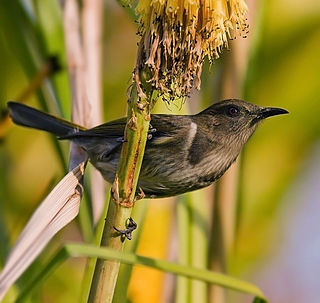
The honeyeaters are a large and diverse family, Meliphagidae, of small to medium-sized birds. The family includes the Australian chats, myzomelas, friarbirds, wattlebirds, miners and melidectes. They are most common in Australia and New Guinea, and found also in New Zealand, the Pacific islands as far east as Samoa and Tonga, and the islands to the north and west of New Guinea known as Wallacea. Bali, on the other side of the Wallace Line, has a single species.

The red wattlebird is a passerine bird native to southern Australia. At 33–37 cm in length, it is the second largest species of Australian honeyeater. It has mainly grey-brown plumage, with red eyes, distinctive pinkish-red wattles on either side of the neck, white streaks on the chest and a large bright yellow patch on the lower belly. The sexes are similar in plumage. Juveniles have less prominent wattles and browner eyes. John White described the red wattlebird in 1790. Three subspecies are recognized.

The blue-faced honeyeater, also colloquially known as the Bananabird, is a passerine bird of the honeyeater family, Meliphagidae. It is the only member of its genus, and it is most closely related to honeyeaters of the genus Melithreptus. Three subspecies are recognised. At around 29.5 cm (11.6 in) in length, the blue-faced species is large for a honeyeater. Its plumage is distinctive, with olive upperparts, white underparts, and a black head and throat with white nape and cheeks. Males and females are similar in external appearance. Adults have a blue area of bare skin on each side of the face readily distinguishing them from juveniles, which have yellow or green patches of bare skin.

Nectar is a sugar-rich liquid produced by plants in glands called nectaries or nectarines, either within the flowers with which it attracts pollinating animals, or by extrafloral nectaries, which provide a nutrient source to animal mutualists, which in turn provide herbivore protection. Common nectar-consuming pollinators include mosquitoes, hoverflies, wasps, bees, butterflies and moths, hummingbirds, honeyeaters and bats. Nectar plays a crucial role in the foraging economics and evolution of nectar-eating species; for example, nectar foraging behavior is largely responsible for the divergent evolution of the African honey bee, A. m. scutellata and the western honey bee.

The noisy friarbird is a passerine bird of the honeyeater family Meliphagidae native to southern New Guinea and eastern Australia. It is one of several species known as friarbirds whose heads are bare of feathers. It is brown-grey in colour, with a prominent knob on its bare black-skinned head. It feeds on insects and nectar.

The friarbirds, also called leatherheads, are a groups of 18 relatively large honeyeaters in the genus Philemon. Additionally, the single member of the genus Melitograis is called the white-streaked friarbird. Friarbirds are found in Australia, Papua New Guinea, eastern Indonesia, and New Caledonia. They eat nectar, insects and other invertebrates, flowers, fruit, and seeds.

The New Guinea crocodile is a small species of crocodile found on the island of New Guinea north of the mountain ridge that runs along the centre of the island. The population found south of the mountain ridge, formerly considered a genetically distinct population, is now considered a distinct species, Hall's New Guinea crocodile. In the past it included the Philippine crocodile, C. n. mindorensis, as a subspecies, but today they are regarded as separate species. The habitat of the New Guinea crocodile is mostly freshwater swamps and lakes. It is most active at night when it feeds on fish and a range of other small animals. A female crocodile lays a clutch of eggs in a nest composed of vegetation and she lies up nearby to guard the nest. There is some degree of parental care for newly hatched juveniles. This crocodile was over-hunted for its valuable skin in the mid 20th century, but conservation measures have since been put in place, it is reared in ranches and the International Union for Conservation of Nature (IUCN) lists it as being of "Least Concern".
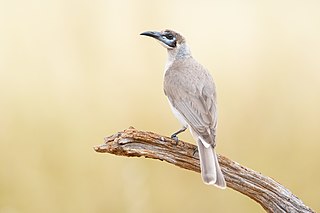
The little friarbird, also known as the little leatherhead or yellow-throated friarbird, is the smallest of the friarbirds within the Philemon genus. It is found throughout northern and eastern Australia as well as southern Papua New Guinea. It lives a very prominent life, whereby it can easily be seen chasing other honeyeaters, and also it is very vocal. However, the little friarbird is usually spotted high up in trees, rarely being seen on the ground.
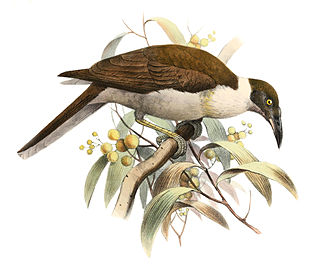
The Manus friarbird or white-naped friarbird, also known as the chauka is a species of bird in the Honeyeater family, or Meliphagidae. It is endemic to the Manus Province of Papua New Guinea.

The helmeted friarbird is part of the Meliphagidae family. The helmeted friarbird, along with all their subspecies, is commonly referred to as “leatherhead” by the birding community.
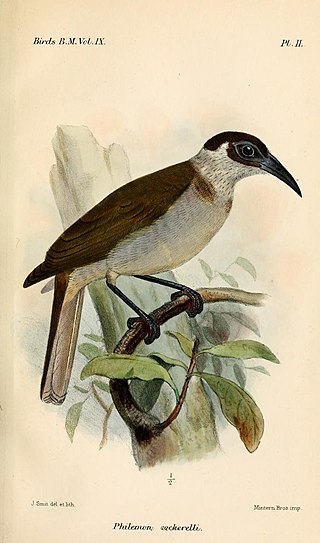
The New Britain friarbird is a species of bird in the family Meliphagidae. It is endemic to Papua New Guinea.
The New Ireland friarbird is a species of bird in the family Meliphagidae. It is endemic to Papua New Guinea.

The Morotai friarbird or dusky friarbird is a species of friarbird in the honeyeater family Meliphagidae. It is a dark brown bird with pale undersides. The area around the eye is bare and pink. It is around 30 cm long. The species is mimicked by the dusky-brown oriole, which is almost identical in appearance, a situation that has arisen in many species of orioles and friarbirds that exist in the same habitat. This is thought to reduce aggression by the friarbirds against the smaller orioles. It is endemic to the island of Morotai in North Maluku, Indonesia.

The Timor friarbird or plain friarbird is a species of bird in the family Meliphagidae.
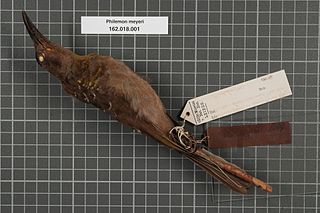
Meyer's friarbird is a species of bird in the family Meliphagidae. It is found throughout New Guinea. Its natural habitat is subtropical or tropical moist lowland forests.

The Buru friarbird or black-faced friarbird is a species of bird in the family Meliphagidae. It is endemic to the island of Buru in the Maluku Islands, Indonesia.

The Seram friarbird, also known as the grey-necked friarbird, Ceram friarbird, grey-necked honeyeater and gray-necked honeyeater, is a species of bird in the family Meliphagidae. It is endemic to Indonesia where it occurs on Seram Island in the Maluku Islands. Its natural habitats are subtropical or tropical moist lowland forests and subtropical or tropical mangrove forests. They are common and conspicuous and often in small groups of up to four individuals.
















